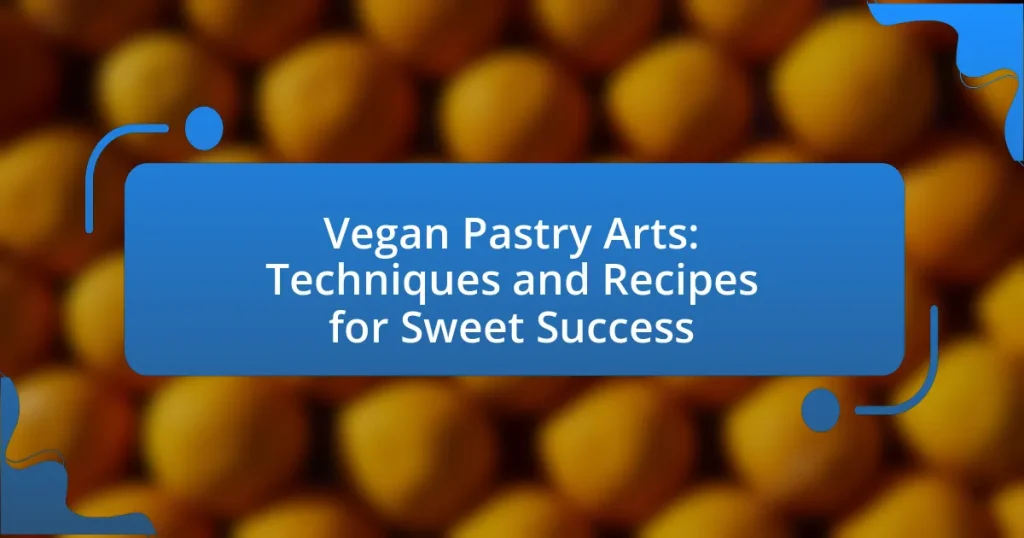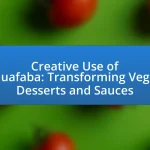Vegan Pastry Arts focuses on the use of plant-based ingredients and innovative techniques to create pastries that mimic traditional textures and flavors. Key components include alternative binding agents like aquafaba and flaxseed, as well as techniques such as creaming and folding. The article explores the differences between vegan and traditional pastry ingredients, common substitutes for dairy and eggs, and essential baking techniques that enhance the quality of vegan pastries. It also addresses challenges in vegan baking, offers troubleshooting tips, and presents popular vegan pastry recipes, emphasizing the importance of seasonal and local ingredients for flavor and sustainability.
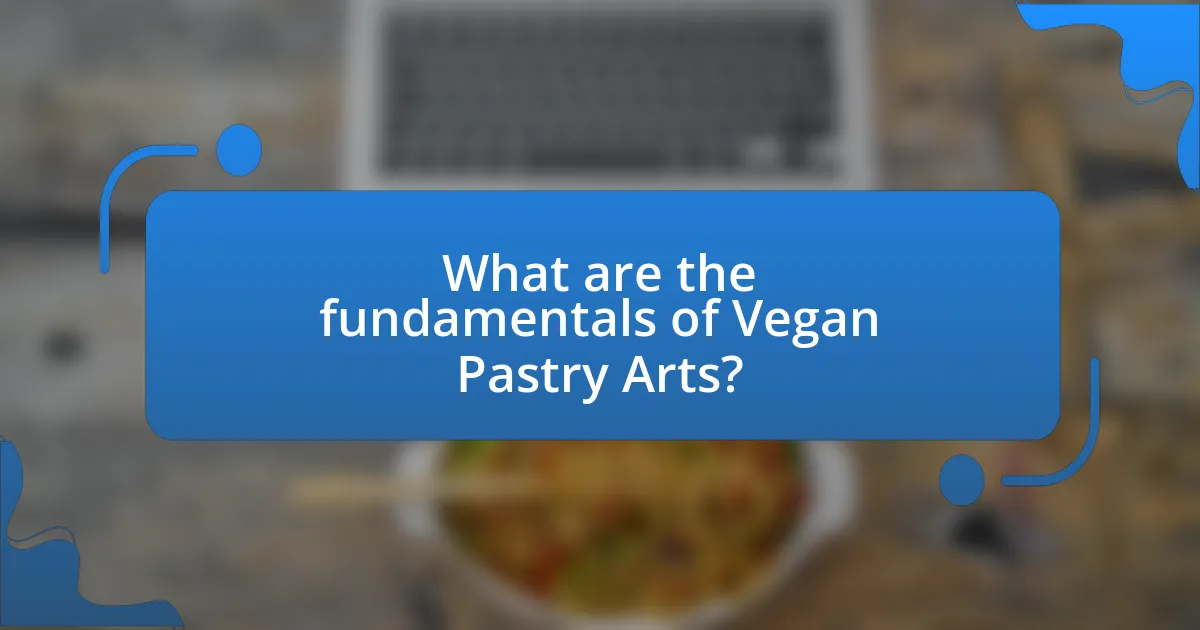
What are the fundamentals of Vegan Pastry Arts?
The fundamentals of Vegan Pastry Arts include the use of plant-based ingredients, alternative binding agents, and innovative techniques to create textures and flavors similar to traditional pastries. Plant-based ingredients such as flour, sugar, and non-dairy milk serve as the foundation, while alternatives like aquafaba, flaxseed meal, or chia seeds act as egg substitutes to provide structure and moisture. Techniques such as creaming, folding, and baking are adapted to accommodate these ingredients, ensuring that the final products maintain desirable qualities like lightness and flakiness. The successful application of these fundamentals allows for the creation of a wide variety of vegan pastries that appeal to both vegan and non-vegan consumers.
How do vegan ingredients differ from traditional pastry ingredients?
Vegan ingredients differ from traditional pastry ingredients primarily by excluding animal products. Traditional pastries typically use ingredients like eggs, butter, and dairy, which provide structure, moisture, and flavor. In contrast, vegan pastries utilize plant-based alternatives such as flaxseed meal or chia seeds for binding, coconut oil or vegan butter for fat, and non-dairy milk for moisture. These substitutions can affect texture and flavor, requiring adjustments in recipes. For example, a study published in the Journal of Food Science found that replacing eggs with flaxseed can alter the emulsification properties, impacting the final product’s consistency.
What are common substitutes for dairy and eggs in vegan pastries?
Common substitutes for dairy in vegan pastries include almond milk, coconut milk, and soy milk, while common substitutes for eggs include flaxseed meal, chia seeds, and applesauce. Almond milk provides a nutty flavor and is low in calories, making it a popular choice. Coconut milk adds richness and creaminess, ideal for desserts. Soy milk is versatile and mimics the texture of cow’s milk. For egg replacements, flaxseed meal and chia seeds create a gel-like consistency when mixed with water, effectively binding ingredients together. Applesauce adds moisture and sweetness, making it suitable for cakes and muffins. These substitutes are widely used in vegan baking to achieve similar textures and flavors as traditional pastries.
How do these substitutes affect texture and flavor?
Substitutes in vegan pastry arts significantly alter both texture and flavor. For instance, using applesauce instead of eggs can create a moist texture while adding a subtle sweetness, enhancing the overall flavor profile. Similarly, substituting coconut oil for butter results in a flaky texture due to its solid state at room temperature, while imparting a distinct coconut flavor. These changes are supported by culinary studies that show how ingredient substitutions can modify the sensory attributes of baked goods, confirming that the choice of substitutes directly impacts the final product’s texture and flavor.
Why is understanding pastry techniques important for vegan baking?
Understanding pastry techniques is crucial for vegan baking because these techniques ensure the desired texture and flavor in the absence of traditional animal-based ingredients. Mastery of methods such as emulsification, leavening, and proper mixing allows bakers to effectively substitute ingredients like eggs and dairy, which are essential for achieving the right consistency and rise in pastries. For instance, using aquafaba as an egg replacement requires knowledge of how to whip it to the correct stiffness to mimic egg whites in meringues. This understanding directly impacts the quality of the final product, making it essential for successful vegan pastry creation.
What are the essential techniques used in vegan pastry arts?
The essential techniques used in vegan pastry arts include aquafaba whipping, plant-based butter creaming, and using alternative binders like flaxseed or chia seeds. Aquafaba, the liquid from cooked chickpeas, can mimic egg whites in recipes, providing structure and stability when whipped. Plant-based butter creaming involves blending vegan butter with sugar to create a light and fluffy texture, essential for frostings and cakes. Additionally, flaxseed or chia seeds mixed with water serve as effective egg substitutes, helping to bind ingredients together in various baked goods. These techniques are foundational for achieving the desired textures and flavors in vegan pastries.
How can mastering these techniques improve baking outcomes?
Mastering baking techniques significantly enhances baking outcomes by ensuring precision in ingredient measurements, temperature control, and mixing methods. For instance, accurate measurements prevent inconsistencies in texture and flavor, while proper temperature regulation during baking can affect the rise and browning of pastries. Research indicates that specific mixing techniques, such as the creaming method, can lead to better incorporation of air, resulting in lighter and fluffier baked goods. Additionally, understanding the role of each ingredient in vegan baking, such as the use of aquafaba as an egg substitute, can improve the overall structure and moisture of the final product.
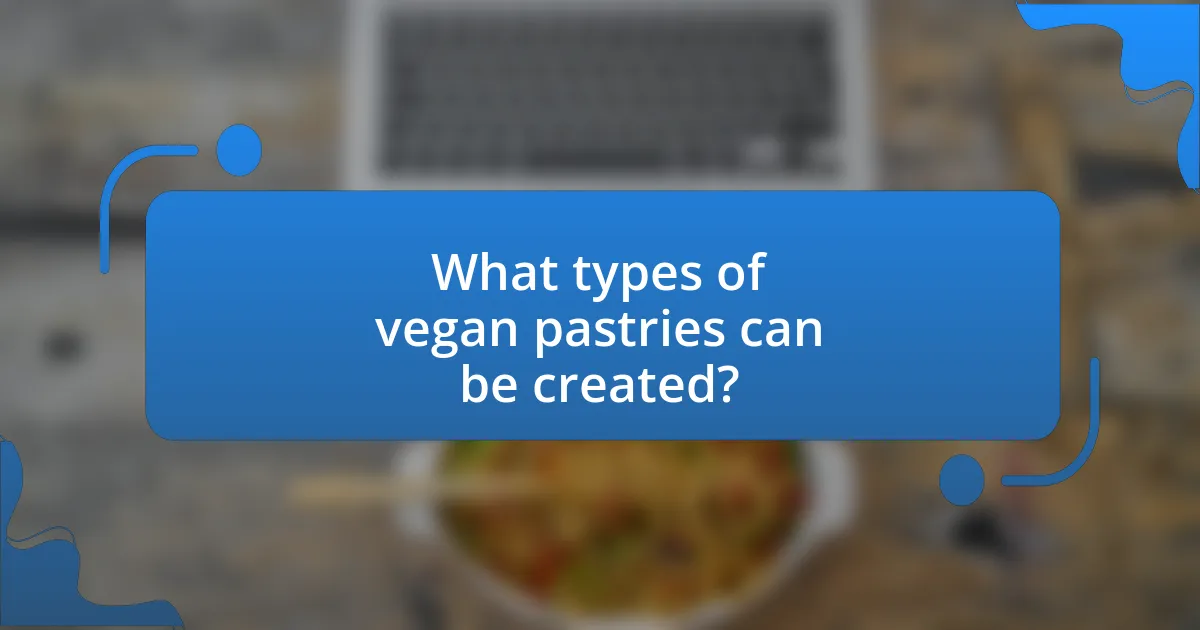
What types of vegan pastries can be created?
Vegan pastries can include a variety of types such as vegan croissants, vegan muffins, vegan tarts, vegan cakes, and vegan cookies. Each of these pastries is made without animal products, utilizing plant-based ingredients like almond milk, coconut oil, and flaxseed as substitutes for dairy and eggs. For instance, vegan croissants are crafted using a dough that incorporates plant-based butter, allowing for the flaky texture characteristic of traditional croissants. Vegan muffins often use applesauce or mashed bananas as egg replacements, while vegan tarts can be filled with fruit or custard made from cashews. The versatility of these ingredients enables the creation of delicious pastries that cater to vegan dietary preferences.
What are the most popular vegan pastry recipes?
The most popular vegan pastry recipes include vegan chocolate cake, vegan croissants, and vegan fruit tarts. Vegan chocolate cake is favored for its rich flavor and moist texture, often made with ingredients like almond milk and flaxseed. Vegan croissants are celebrated for their flaky layers, achieved through the use of plant-based butter and careful folding techniques. Vegan fruit tarts are appreciated for their vibrant presentation and can be filled with cashew cream or coconut cream, topped with fresh fruits. These recipes are widely shared and adapted in vegan cooking communities, highlighting their popularity and versatility.
How do you make vegan croissants from scratch?
To make vegan croissants from scratch, start by preparing a dough using all-purpose flour, yeast, sugar, salt, and plant-based butter. Combine the flour, yeast, sugar, and salt in a bowl, then add warm water and mix until a dough forms. Knead the dough for about 10 minutes until smooth, then let it rise for 1-2 hours until doubled in size.
Next, roll out the dough into a rectangle and layer it with chilled plant-based butter, folding it into thirds to create layers. Roll the dough out again and repeat the folding process several times to achieve a flaky texture. After the final fold, refrigerate the dough for at least 30 minutes.
Once chilled, roll the dough into a large rectangle, cut it into triangles, and roll each triangle from the base to the tip to form croissants. Place them on a baking sheet, let them rise for another hour, and then bake at 375°F (190°C) for 15-20 minutes until golden brown. This method ensures a flaky and delicious vegan croissant, similar to traditional recipes that rely on dairy butter for flakiness.
What are the steps to create a vegan cheesecake?
To create a vegan cheesecake, follow these steps: First, prepare the crust by combining crushed vegan cookies or nuts with melted coconut oil and pressing the mixture into the bottom of a springform pan. Next, blend soaked cashews, coconut cream, maple syrup, lemon juice, and vanilla extract until smooth to form the cheesecake filling. Pour the filling over the crust and smooth the top. Refrigerate the cheesecake for at least four hours or until set. Finally, garnish with fresh fruit or a fruit compote before serving. These steps ensure a creamy, delicious vegan cheesecake that mimics traditional recipes while adhering to vegan dietary restrictions.
How can seasonal ingredients enhance vegan pastries?
Seasonal ingredients enhance vegan pastries by providing optimal freshness, flavor, and nutritional value. Utilizing fruits and vegetables at their peak ripeness ensures that the pastries are more flavorful and aromatic, which can significantly elevate the overall taste experience. For example, using ripe strawberries in spring or pumpkins in autumn not only adds vibrant colors but also contributes essential vitamins and minerals, making the pastries healthier. Additionally, seasonal ingredients often have a lower carbon footprint due to reduced transportation needs, aligning with sustainable practices in vegan baking. This approach not only supports local agriculture but also encourages creativity in pastry-making, as bakers can experiment with unique flavor combinations that reflect the changing seasons.
What are some examples of seasonal fruits and their uses in pastries?
Seasonal fruits such as strawberries, peaches, and apples are commonly used in pastries. Strawberries, available in late spring to early summer, are often incorporated into tarts and cakes, providing a fresh, sweet flavor. Peaches, which peak in summer, are frequently used in cobblers and galettes, adding a juicy texture and aromatic sweetness. Apples, harvested in fall, are ideal for pies and crumbles, offering a balance of sweetness and tartness. These fruits not only enhance the flavor profile of pastries but also contribute to their visual appeal and nutritional value.
How does using local ingredients impact flavor and sustainability?
Using local ingredients enhances flavor and sustainability by providing fresher produce and reducing carbon footprints associated with transportation. Freshness from local sourcing often results in more vibrant flavors, as ingredients are harvested at peak ripeness and consumed shortly after. Additionally, studies show that local food systems can reduce greenhouse gas emissions by up to 11 times compared to conventional food systems due to decreased transportation distances. This dual impact of improved taste and environmental benefits makes local ingredients a crucial choice in vegan pastry arts.
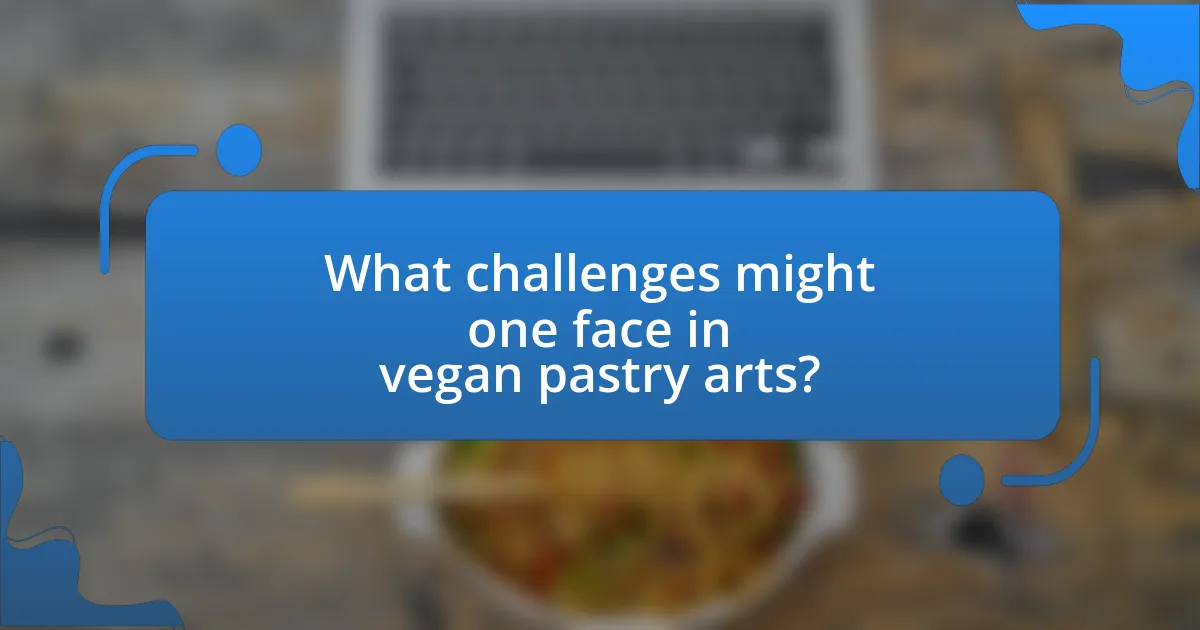
What challenges might one face in vegan pastry arts?
One challenge in vegan pastry arts is the difficulty in replicating the texture and flavor of traditional pastries without animal products. This challenge arises because many conventional baking ingredients, such as eggs and dairy, contribute to moisture, structure, and richness in pastries. For instance, eggs provide binding and leavening properties, which can be hard to substitute effectively. Additionally, achieving the right balance of flavors and textures often requires experimentation with alternative ingredients like aquafaba, flaxseed meal, or plant-based milks, which may not yield consistent results. This complexity is supported by the fact that many vegan substitutes behave differently than their animal-based counterparts, leading to potential failures in achieving the desired pastry outcome.
What are common pitfalls when baking vegan pastries?
Common pitfalls when baking vegan pastries include improper ingredient substitutions, inadequate moisture levels, and neglecting to account for baking times. Using the wrong type of fat, such as coconut oil instead of a liquid oil, can lead to a dense texture. Additionally, vegan recipes often require more moisture due to the absence of eggs, so failing to adjust liquid ingredients can result in dry pastries. Lastly, overbaking is a frequent mistake, as vegan pastries can dry out more quickly than those made with eggs. These factors can significantly affect the final product’s taste and texture.
How can one avoid issues with texture in vegan pastries?
To avoid issues with texture in vegan pastries, one should use a combination of appropriate binding agents and moisture-retaining ingredients. For instance, incorporating flaxseed meal or chia seeds as egg substitutes can provide structure and moisture, while ingredients like applesauce or silken tofu can enhance the overall texture. Research indicates that the right balance of wet and dry ingredients is crucial; for example, a study published in the Journal of Food Science found that the use of aquafaba (chickpea brine) can significantly improve the aeration and lightness of vegan baked goods. By carefully selecting and measuring these components, one can achieve a desirable texture in vegan pastries.
What strategies can help in achieving the right sweetness level?
To achieve the right sweetness level in vegan pastries, utilize a combination of natural sweeteners, adjust ingredient ratios, and taste-test throughout the process. Natural sweeteners like maple syrup, agave nectar, or coconut sugar can provide varying degrees of sweetness and flavor complexity. Adjusting the ratios of sweeteners to other ingredients, such as flour or fats, can help balance the overall taste. Regular taste-testing during preparation allows for real-time adjustments, ensuring the final product meets desired sweetness levels. These strategies are effective as they cater to personal preferences and the unique characteristics of vegan ingredients.
How can one troubleshoot common vegan pastry problems?
To troubleshoot common vegan pastry problems, one should first identify the specific issue, such as dryness, crumbling, or lack of rise. For dryness, increasing the moisture content by adding more plant-based milk or oil can help. If the pastry is crumbling, incorporating a binding agent like flaxseed meal or chia seeds mixed with water can improve texture. For lack of rise, ensuring the use of fresh baking powder or baking soda and properly measuring ingredients can enhance leavening. These solutions are supported by the fact that moisture balance and proper leavening are critical in vegan baking, as noted in various baking guides and culinary studies.
What are effective solutions for undercooked vegan pastries?
To effectively address undercooked vegan pastries, re-bake them at a lower temperature for a longer duration. This method allows the heat to penetrate evenly without burning the outer layers, ensuring thorough cooking. For instance, if the initial baking temperature was 350°F, reducing it to 325°F and extending the baking time by 10-15 minutes can help achieve the desired doneness. Additionally, using a toothpick to check for doneness can provide a reliable indicator; if it comes out clean or with minimal crumbs, the pastry is properly cooked.
How can one fix overly dense vegan baked goods?
To fix overly dense vegan baked goods, one can incorporate additional leavening agents such as baking powder or baking soda. These agents create air pockets during baking, which lightens the texture. Additionally, increasing the liquid content, such as plant-based milk or aquafaba, can help improve moisture and aeration. Using lighter flours, like cake flour instead of all-purpose flour, can also contribute to a fluffier result. These adjustments are supported by baking science, which indicates that proper leavening and moisture balance are crucial for achieving the desired texture in baked goods.
What are some best practices for successful vegan pastry baking?
Successful vegan pastry baking requires careful ingredient selection, precise measurements, and an understanding of vegan substitutes. Using high-quality plant-based ingredients, such as aquafaba for egg replacement or coconut oil for butter, enhances texture and flavor. Accurate measurements are crucial, as vegan pastries can be sensitive to ratios; for instance, using the right amount of flour and liquid ensures proper structure. Additionally, incorporating techniques like chilling dough to improve flakiness and allowing adequate baking time for even cooking are essential. These practices are supported by numerous vegan baking resources, which emphasize the importance of ingredient quality and technique in achieving desirable results.
